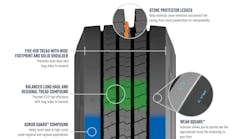It takes years to grow a bulk transportation fleet from the ground up.
Tank truck companies must navigate economic downturns and a never-ending maze of regulations. And all the while the industry grows more competitive, and a steady stream of new safety and efficiency products continually promises to further enhance operations. It can feel overwhelming—so it makes sense to focus on the basics.
No matter what class of tractor, or type of tank trailer the carrier utilizes, tires are the elemental thread that binds bulk transporters together on the nation’s highways. Tires aren’t the flashiest fleet equipment, but they’re truly important. Just ask anyone stranded on the side of the road with a flat.
Yet how much do fleet owners really know about the tires they regularly purchase in high volumes and must maintain? When was the last time each tire was serviced? Are any tires currently leaking air, and waiting to surprise a driver on the road?
Tank truck drivers strive each day to maintain safe, reliable equipment, but they’re also tasked with some of the most challenging loading and offloading jobs in trucking, so a system that actively helps them maintain proper tire pressure also allows them to focus on their segment-specific duties. And while fleet managers are spec’ing tank trucks with electronic stability controls and other safety systems, they’re often not enough to guarantee peace of mind with highly sensitive cargoes.
Some companies then turn to a basic tire pressure monitoring system (TMPS), but is that enough? Or should bulk transportation companies consider a more active system, one that also helps transition them into a predictive maintenance program—like Aperia Technologies’ Halo Connect.
Intelligent inflation
In today’s just-in-time delivery environment, a common shortcoming of tire pressure monitoring systems is that while they report pressure, they cannot proactively take steps to fix a potentially dangerous situation.
These systems traditionally monitor each tire based on a pre-set level, and issue alerts based on the difference between that target and the actual measured pressure. While it’s good these reactive systems alert the driver to a problem, threshold-based alerts don’t reveal whether a tire is leaking or simply hasn’t been serviced recently. That means it still falls on a driver to further diagnose the problem, if possible, and report it to the office.
Even systems that automatically inflate tires may not be able to accurately alert drivers to whether or not proper pressure is maintainable without additional actions. In the absence of leak classifications, fleets can only be alerted to issues. They don’t gain insight into how quickly technicians must respond.
This can result in disruptive and costly downtime due to the extended time it takes to diagnose—and then fix—each tire problem uncovered.
An alternative to a basic TPMS is the Halo Connect tire inflation and analytics platform from Aperia Technologies. By combining active inflation and machine learning-powered analytics to correct tire problems before they occur, and predict when maintenance is required, Halo Connect can improve productivity, extend tire life and boost fuel efficiency.
One fleet study cited by Aperia illustrates the real-world impact of active inflation combined with predictive alerts. After using Halo Connect, the overall number of alerts requiring attention declined by about 75%. On a per-truck basis, that translates into 3.4 alerts per truck annually with Halo Connect, compared with 16.5 alerts per truck with a basic TPMS. Projecting that out over a five-year period, the fleet estimated total tire maintenance costs would be two-and-a-half times lower with Halo Connect as a result of reduced labor, tire damage and unplanned maintenance.
Costly challenges
Successful trucking fleets have long known that traditional tire pressure maintenance practices, which rely on drivers manually checking pressures, aren’t sufficient to keep tires at optimal levels. This is of particular concern for bulk transporters, who face challenges other operators do not because they haul potentially flammable and hazardous materials, as well as liquids that could spoil in unplanned downtime.
Maintaining proper tire inflation helps reduce the risk of unexpected vehicle breakdowns, and contributes to improved fuel efficiency, reduced tire wear and longer casing life.
It’s true that tire issues are unavoidable in many situations, such as striking debris on a highway. But far too often, carriers are simply unaware their tires are improperly inflated, which is the largest cause of non-hazard-related tire failures.
Research from the Technology & Maintenance Council (TMC) showed that approximately one out of five commercial vehicles are operating with one or more tires underinflated by at least 20 pounds per square inch (psi). In addition, only 46% of all tractor tires and 38% of all trailer tires are within plus or minus 5 psi of the target pressure. The group also recommended that any tire found to be inflated to less than 80% of target pressure should be inspected, and that a tire underinflated by 50% or more should be considered flat.
Underinflation leads to an estimated 10% to 12% degradation in wear for an individual tire that is 10 psi underinflated, and a 1% dip in fuel economy for a vehicle running with all tires underinflated by 10 psi.
Developing tire problems are often invisible—or at least not easily detected by the naked eye—and can quickly lead to failures if not caught early. A recent study found the average fleet ran more than 33,000 miles between unexpected breakdowns, meaning it’s not a matter of if, but when, a problem will occur.
Research from TMC and FleetNet America also found the cost of an unscheduled truck repair averages nearly $500—a figure that continues to rise each year.
Tires are among the components most often responsible for these unplanned roadside repairs and continue to be among the most frequent infractions cited as part of the federal government’s Comprehensive, Safety, Accountability (CSA) program. These violations hit the overall safety scores of the driver and the fleet.
Proper inflation also reduces the chance of tire damage while in-transit, and that bulk shipments arrive on time. That helps develop long-lasting relationships with shippers and customers, and helps further establish a positive reputation. Likewise, a tank fleet’s public image could potentially be damaged if a truck is involved in a highway accident caused by a tire blowout.
Real-time response
One potential drawback of a TPMS is that drivers, technicians and other employees must be able to quickly understand a slew of signals and warnings.
Otherwise, the system’s usefulness is immediately undercut.
Many fleets have found when a tire pressure threshold is set too high, drivers can be inundated with alerts, leading them to tune out the noise and not take corrective actions. Conversely, a decision to set the threshold too low may not provide enough warning of an imminent tire failure, undercutting the goal of the technology.
Unlike other systems, Aperia’s proprietary algorithms factor in countless variables, detecting problems far in advance of a pressure gauge or TPMS system. Once installed, Halo Connect reduces the number of alerts and warnings by 75%, compared with traditional systems. Halo’s algorithms recognize how individual tires are performing, and can correct potential problems in real time, such as slow leaks, without any input from human interaction.
According to Aperia, fleets regularly credit Halo Connect for eliminating four-fifths of all health issues with their tires. In cases where more serious warnings are warranted, drivers and fleet officials are notified more than 60% earlier than TPMS systems, while tires still are within their target pressure ranges.
By flagging problem tires before they drop below the target pressure and categorizing maintenance issues by severity, fleets can greatly reduce downtime through more efficient and cost-effective maintenance planning. When factored together, there is a greater than 90% reduction in roadside calls, Aperia said.
Data is continually captured by the system and compared with historical markers to spot early warning signs of potential failures. It also helps determine the best tire make and model for individual vehicles, based on duty cycles, routes, shipments and other factors. Likewise, fleets can better reach the mileage figures promoted by tire manufacturers, something many struggle to achieve.
These features enable fleet managers to confidently make decisions about where and when to service tires, minimizing disruptions and maximizing equipment utilization.
In situations that require immediate action, drivers can be rapidly re-routed to service locations, where technicians have already been alerted to the problem and are prepped to minimize downtime. At the same time, the health of every tire in the fleet can be accessed with the click of a mouse, while knowing the target tire pressure is best for wear, braking, handling, comfort and fuel consumption at all times and under all conditions.
And Aperia’s commitment to accelerating enhancements as Halo Connect evolves includes incorporating new features as they become available, including terminal-specific tire program performance tracking, supplier performance tracking, API integration capabilities, full trailer connectivity, global support infrastructure and tire casing asset management.
All these offerings can help turn what used to be one of the most uncertain areas of a bulk transporter’s business into one that delivers a higher level of safety and financial security than previously thought possible.



